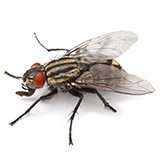House Fly
House flies get their name because they are the most common fly in and around homes; however, they occur everywhere.
Nesting Habits
House flies can fly up to 20 miles but, when food is available, will usually remain within 1-2 miles/1.6-3.2 kilometers of their larval habitat. For egg laying purposes, females seek warm, moist organic material. Odors and temperatures attract them to buildings.
Upon landing on a surface or material, the fly regurgitates or vomits a little of its stomach contents and digestive juices. It then sops it up with its sponging mouthparts. If it’s nutritious, it will continue to feed, and may lay eggs. Otherwise, it flies away leaving a “fly spot.”
House flies are most active during the day in warm weather.
Damage
House flies are not only a nuisance pest; more importantly, they can be a carrier of many disease organisms, such as typhoid fever, cholera, diarrhea, dysentery, tuberculosis, anthrax, ophthalmia, polio and salmonellosis, as well as parasitic worms, which they can transmit via vomit, feces and contaminated parts of their body. Controlling house flies is of major importance in maintaining food safety.
Common Characteristics
Color
Dull gray; thorax with four dark stripes.
Common Length
1/8-1/4 of an inch (4-7.5 millimeters)
Adults measure 1/8-1/4 of an inch (4-7.5 millimeters) long; the female is often larger than the male. Dull gray; thorax with four dark stripes.
House flies feed on a wide variety of moist materials – from excrement to human foods.
Adult females lay white, oval-shaped eggs in moist materials that hatch within eight to 20 hours. Depending on conditions, developmental time (egg to adult) can take six to 12 days. Adults can live 15-25 days.
As with green bottle flies, keeping house flies out of a facility to prevent food contamination in the summer is a challenge, especially later in the summer when fly populations are huge. It’s also difficult where there are abundant breeding sites (e.g. farm manure) within a few miles.
Related Blog Posts
Flying Insects That Love Your Business
The sight of flies buzzing around your business can turn customers away and put your...
Read More
Pest Management Considerations After Flooding
The severe flooding parts of the country have experienced over the last couple of months...
Read More
Reduce Pest Attractiveness with Lighting Scheme Modifications
By Bennett Jordan,Ph.D., BCE, excerpt from 2017 PRSM Best Practices CHALLENGE Retail stores need lighting...
Read More
Tech Talk – Fruit Fly Management In a Commercial Setting
By Daniel Hill When handling fruit flies, how many times have you said to a...
Read More
Maggots and Flies – Connecting the Dots
The fly you see buzzing around inside may represent far more of a problem than...
Read More
Commercial Lighting Solutions to Combat Night-Flying Pests
Outdoor lighting plays a big part in commercial pest control. In fact, the wrong lighting...
Read More
[Tech Talk] What’s All the Buzz About?
I consider myself both a good entomologist and an ever-evolving backyard beekeeper. So imagine my...
Read More
[Tech Talk] Making the Most of All Four Seasons
By Bill Kolbe, BCE If bad winters sound discouraging, watch the award-winning movie March of...
Read More
August Is Fly Month With Copesan
This is a busy time of year for the green bottle fly, the house fly...
Read More
Drain Flies And Your Business
As most business owners know, drain flies can be a real nuisance. These flies breed...
Read More
[Tech Talk] You Too Can Relocate Honey Bee Swarms and Nucleus Colonies
Well before commercial pesticide applicators came under scrutiny as the result of honey bee colony...
Read More
Protect Your Business From Aggressive Yellowjackets
The month of September is the time of year for yellowjackets. These stinging insects live...
Read More
The Dangers Of Flies In Commercial Establishments
Flies are very common pests and can be found just about anywhere; however, this does...
Read More
The Increased Threat Of Stinging Insects In Late Summer
Why Do These Bugs Come Out in Late Summer? Stinging insects can be seen all...
Read More
Important Fly Prevention Tips For Business Owners
Flies are nuisance pests, but in a commercial environment they can become a severe problem...
Read More
The Buzz On Bottle Flies
In commercial facilities, bottle flies can quickly become a problem. These large flies are known...
Read More
Changing Insecticide Labeling in Regards to Pollinators
Author’s note: This column was written prior to the release of a recent report by USDA....
Read More
How To Prevent Stinging Insects On Site
No matter what the species or size, seeing a stinging insect is enough to put...
Read More

